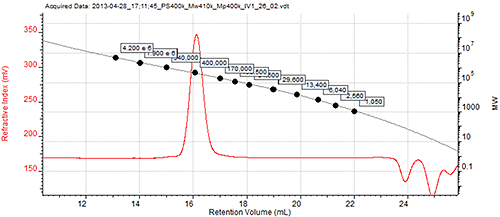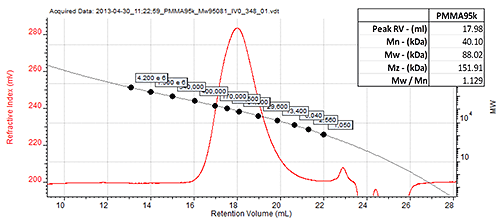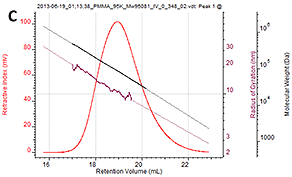The physical properties and behavior of polymers depends strongly on the properties of the polymer molecules themselves. Molecular weight and molecular weight distribution, molecular size and structure all affect how the material will behave. Gel-permeation chromatography (GPC), also called size-exclusion chromatography (SEC), is the most commonly used tool for assessing these parameters.
The principle of GPC involves separating the sample as it travels through a porous but inert column matrix. While smaller molecules penetrate the pores more deeply, larger molecules are excluded and thus travel through the column faster. The result is a separation based on hydrodynamic volume but the desire is to know the molecular weight of the sample.
The Malvern SEC-MALS 20 system is a 20 angle light scattering detector capable of making measurements of molecular weight and Rg (radius of gyration). It is used as part of a multi-detector GPC system that combines light scattering with other detectors such as refractive index (RI), ultraviolet (UV) and intrinsic viscosity (IV) to generate a large amount of information about a sample simultaneously.

|
In this application note, the molecular weight, molecular weight distribution and size of two common polymers are measured using SEC-MALS. The results from SEC-MALS are compared with those from conventional calibration and the differences are discussed.
The SEC-MALS 20 system was connected to a Viscotek GPCmax and a Viscotek VE3580 RI detector. Samples were separated using two Viscotek T6000M columns. The mobile phase was THF stabilized with 300 ppm BHT. Samples were allowed to dissolve overnight to ensure full dissolution. The SEC-MALS system was calibrated with a traceable 105 kDa polystyrene standard. The conventional calibration setup was calibrated with a series of polystyrene standards of known molecular weights.
The detectors and columns were all held at 35°C to ensure a good separation and maximize baseline stability.
The two samples analyzed in this note are a broad distribution polystyrene sample with a molecular weight of 235 kDa (2.35 x 105 g/mol) and a broad distribution polymethylmethacrylate (PMMA) sample. Both were dissolved in the mobile phase and then run through the system. Their molecular weights were measured using both conventional calibration and the SEC-MALS 20.

|

|

|

|

|
A chromatogram of the 235 kDa polystyrene sample with high polydispersity is shown in figure 2A. The inset table shows the measured molecular weight. The Viscotek SEC-MALS 20 measures light scattering intensity at 20 angles and the full angular data is shown in figure 2B. The molecular weight and Rg distributions are shown in figure 2C. Rg has been measured across approximately three quarters of the peak, corresponding to the area where the molecules are large enough to scatter light anisotropically and therefore have Rg measured, and this is plotted in the maroon line. A Debye plot showing the angular dependence of the scattered light is shown in figure 2D. At a retention volume of approximately 18 ml, the size of the molecules are small enough that they are isotropic scatterers which means they scatter light evenly in all directions. An example of a Debye plot from this region can be seen in figure 2E. The slope the line is virtually zero and an Rg cannot be measured. Therefore, the Rg distribution ends at approximately 10 nm, which is the lower Rg limit for SEC-MALS, and is extrapolated from this point forwards.

|
Historically, measurements of molecular weight using GPC were made using a conventional calibration curve made of a series of standards of known molecular weight. For this work, a calibration curve was created using a series of polystyrene standards. The curve can be seen in figure 3 overlaid on a chromatogram of PS400k, a 4x105 g/mol standard used as part of the calibration curve.
A sample of polymethylmethacrylate (PMMA) was dissolved in the mobile phase and separated on the system. Figure 4 shows its chromatogram overlaid with the same polystyrene conventional calibration curve. The molecular weight results are shown in the inset table.

|
Table of molecular weight results shown inset.
This sample is actually known to have a molecular weight of 9.5 x 104 g/mol from low-angle light scattering (LALS) measurements. However its measured molecular weight using conventional calibration is approximately 85 kDa and is therefore significantly underreported. The reason for this is that the PMMA has a different size/molecular weight relationship to the polystyrene standards used in the calibration, which is to say that it has a different structure. Molecules of similar molecular weight therefore will elute at different retention volumes. This confirms that if polystyrene is used to create a conventional calibration curve and PMMA is the sample, the measured molecular weight will be incorrect. This relationship is actually defined by the molecule's intrinsic viscosity but this parameter is discussed in other application notes (ref MRK 1925).
On the other hand, molecular weight measurements by light scattering are independent of the sample retention volume. Therefore, when this PMMA sample is measured, the results should be more accurate. Measuring the sample using the Viscotek SEC-MALS 20 produced the results shown in figure 5.

|

|

|
Figure 5A shows the chromatogram for the PMMA sample including both the RI and the SEC-MALS 90° signals. The inset table shows that the measured molecular weight is 94 kDa, very close to the correct value measured by LALS. The molecular weight has therefore been measured by the SEC-MALS with far greater accuracy than by conventional calibration. The measured molecular weight is shown in figure 5C overlaid on the RI chromatogram. As discussed above for the polystyrene sample, using MALS also allows the measurement of Rg for molecules large enough to scatter light anisotropically. Figure 5C shows the measured Rg across most of the peak. The measured average Rg is 10.2 nm. In the descending edge of the peak as the size of the molecules falls below 10 nm, the Rg can no longer be measured as the sample is scattering light isotropically in this region.
The addition of a light scattering as a detector to a GPC system adds the ability to accurately measure the molecular weight of any polymer, independently of its elution volume. The Malvern SEC-MALS 20 is shown here to successfully measure the molecular weight of both a polystyrene and a PMMA sample. The molecular weight of the PMMA measured using SEC-MALS is different to that calculated using conventional calibration because the different structures of the different polymers. This leads to incorrect measurements of molecular weight when conventional calibration is used but is not a problem for the SEC-MALS 20 which measures the absolute molecular weight independent of sample retention volume.